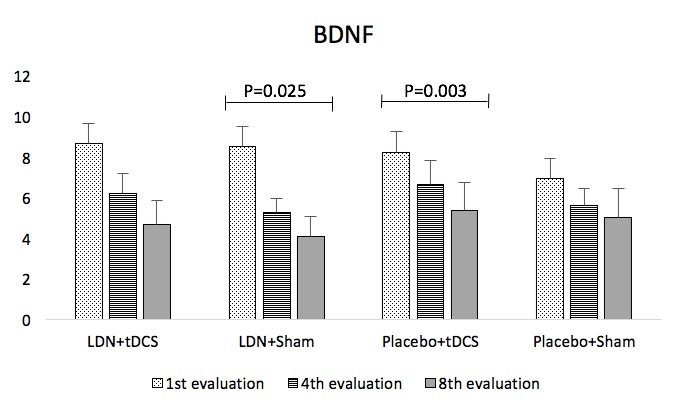Abstract 01
Brain-derived neurotrophic factor (BDNF) after associating low-dose naltrexone (LDN) and transcranial direct current stimulation (tDCS) in patients with fibromyalgia
Mariane Schäffer Castro 1; Rodrigo Hernandes Paludo 1; Iraci Lucena da Silva Torres 2,3; Wolnei Caumo 2,3; Felipe Fregni 4,3; Liciane Fernandes Medeiros 2,5; Andressa de Souza 2,3,5.
- Discente da Universidade La Salle, Canoas/RS
- Programa de Pós-Graduação em Ciências Biológicas: Farmacologia e Terapêutica. Universidade Federal do Rio Grande do Sul, Porto Alegre/RS
- Programa de Pós-Graduação em Ciências Médicas: Medicina. Universidade Federal do Rio Grande do Sul, Porto Alegre/RS
- Neuromodulation Center and Center for Clinical Research Learning. Spaulding Rehabilitation Hospital and Massachusetts General Hospital, Boston/MA
- Programa de Pós-Graduação em Saúde e Desenvolvimento Humano da Universidade La Salle, Canoas/RS
OBJECTIVE: Evaluate the effect of the association of Low-Dose Naltrexone (LDN) and Transcranial Direct Current Stimulation (tDCS) for the treatment of fibromyalgia (FM) through BDNF levels.
METHODS: This is a randomized clinical trial in which 86 women from 18 to 65 years old with FM diagnosis were included. Patients were randomized between LDN+tDCS (n=21); LDN+Sham(n=22); Placebo+tDCS (n=22) or Placebo+Sham (n=21), receiving 21 consecutive days of medication and 5 days of association. Procedures: sociodemographic questionnaire, Visual Analogue Scale (VAS) and blood collection for BDNF serum levels (ELISA method). Data were analyzed in SPSS 20.0, using Friedman’s test followed by Wilcoxon’s Post Hoc, considering significant difference when P<0.05.
RESULTS: Patients did not present significant difference between groups in baseline, demonstrating a homogeneous sample. Groups that received only one active intervention (LDN or tDCS) presented significant reduction in BDNF serum levels when comparing the last day of treatment with baseline (P=0.025 and P=0.003, respectively). VAS presented a significant reduction in the following groups between last evaluation and baseline: LDN+tDCS (P=0.010), LDN+Sham (P=0.001) and Placebo+Sham (P=0.011).
CONCLUSIONS: Association (LDN+tDCS) was not superior to isolated interventions; however, this study results corroborate with previous ones that evaluated the use of each intervention, demonstrating a reduction in serum levels of BDNF and pain.
FIGURE

KEYWORDS: Fibromyalgia; Transcranial Direct Current Stimulation; Low-Dose Naltrexone
ACKNOWLEDGMENTS: None
FUNDING/FINANCIAL SUPPORT: None
